JUC
1.多线程操作共享数据
1.多线程操作共享数据时,会出问题,那么就可以使用java.util.concurrent.Atomic类定义共享数据,这个工具包保证类中的数据都具有原子性.
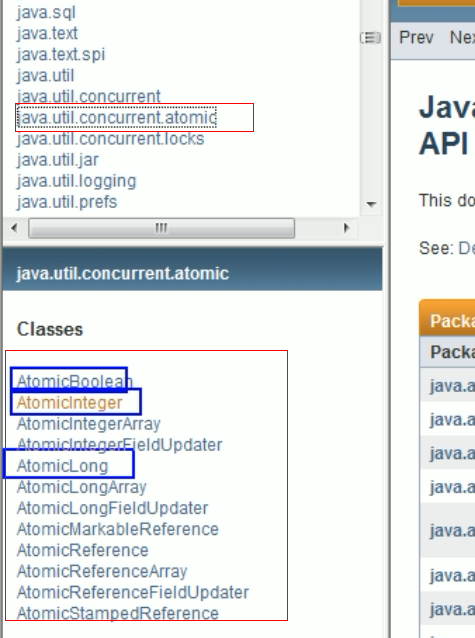
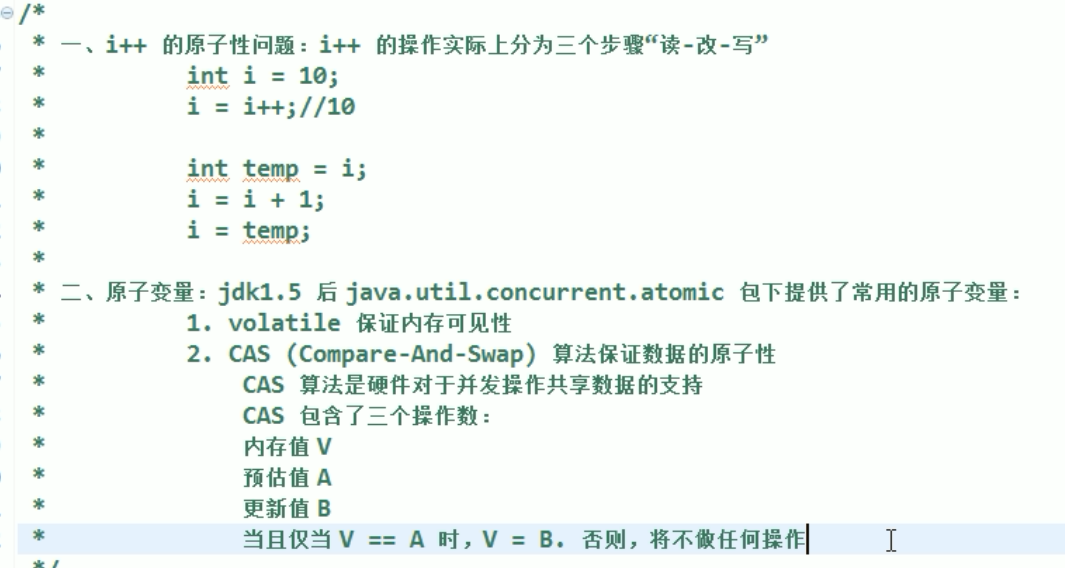
具体实例如下:

package com.atguigu.juc; import java.util.concurrent.atomic.AtomicInteger; /* * 一、i++ 的原子性问题:i++ 的操作实际上分为三个步骤“读-改-写” * int i = 10; * i = i++; //10 * * int temp = i; * i = i + 1; * i = temp; * * 二、原子变量:在 java.util.concurrent.atomic 包下提供了一些原子变量。 * 1. volatile 保证内存可见性 * 2. CAS(Compare-And-Swap) 算法保证数据变量的原子性 * CAS 算法是硬件对于并发操作的支持 * CAS 包含了三个操作数: * ①内存值 V * ②预估值 A * ③更新值 B * 当且仅当 V == A 时, V = B; 否则,不会执行任何操作。 */ public class TestAtomicDemo { public static void main(String[] args) { AtomicDemo ad = new AtomicDemo(); for (int i = 0; i < 10; i++) { new Thread(ad).start(); } } } class AtomicDemo implements Runnable{ // private volatile int serialNumber = 0; private AtomicInteger serialNumber = new AtomicInteger(0); @Override public void run() { try { Thread.sleep(200); } catch (InterruptedException e) { } System.out.println(getSerialNumber()); } public int getSerialNumber(){ return serialNumber.getAndIncrement(); } }
2.concurentHashMap
因为hashtable是线程安全的,但是效率低,所以concurrentHashMap用于替换hashtable.hashtable对象只有一个锁,所以效率会极低,但是cocurrentHashMap中使用的是分段锁,即有多个锁,每个锁负责一部分数据.这样多线程访问时就是并行操作而不是像hashtable那样的串行.如下截图:
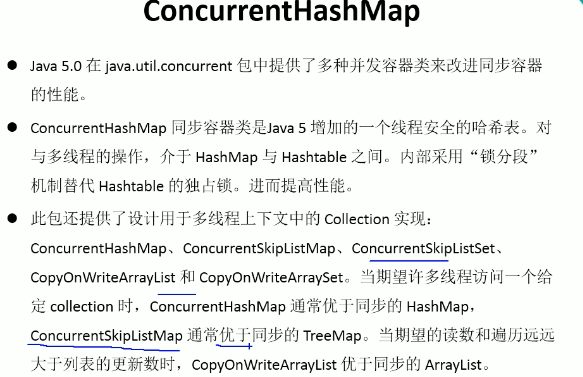

package com.atguigu.juc; import java.util.Iterator; import java.util.concurrent.CopyOnWriteArrayList; /* * CopyOnWriteArrayList/CopyOnWriteArraySet : “写入并复制” * 注意:添加操作多时,效率低,因为每次添加时都会进行复制,开销非常的大。并发迭代操作多时可以选择。 */ public class TestCopyOnWriteArrayList { public static void main(String[] args) { HelloThread ht = new HelloThread(); for (int i = 0; i < 10; i++) { new Thread(ht).start(); } } } class HelloThread implements Runnable{ // private static List<String> list = Collections.synchronizedList(new ArrayList<String>()); private static CopyOnWriteArrayList<String> list = new CopyOnWriteArrayList<>(); static{ list.add("AA"); list.add("BB"); list.add("CC"); } @Override public void run() { Iterator<String> it = list.iterator(); while(it.hasNext()){ System.out.println(it.next()); list.add("AA"); } } }
3.countDownLatch闭锁
闭锁:在完成某些运算时,只有其他所有的线程运算全部完成,当前运算才继续执行.
例如在主线程中计算多线程执行的时间,因为主线程和在主线程中开启的多线程是同步操作,即主线程不会等待所有子线程执行完才会的操作.所以就需要使用闭锁,让主线程在多线程执行时等待,执行完后计算时间差.如下代码:

package com.atguigu.juc; import java.util.concurrent.CountDownLatch; /* * CountDownLatch :闭锁,在完成某些运算是,只有其他所有线程的运算全部完成,当前运算才继续执行 */ public class TestCountDownLatch { public static void main(String[] args) { //50的数字必须要和开启的线程数相同,因为每个线程执行完都要让锁个数减一 final CountDownLatch latch = new CountDownLatch(50); LatchDemo ld = new LatchDemo(latch); long start = System.currentTimeMillis(); for (int i = 0; i < 50; i++) { new Thread(ld).start(); } try { latch.await(); } catch (InterruptedException e) { } long end = System.currentTimeMillis(); System.out.println("耗费时间为:" + (end - start)); } } class LatchDemo implements Runnable { private CountDownLatch latch; public LatchDemo(CountDownLatch latch) { this.latch = latch; } @Override public void run() { try { for (int i = 0; i < 50000; i++) { if (i % 2 == 0) { System.out.println(i); } } } finally { //线成执行完成后闭锁减一 latch.countDown(); } } }
4.实现callable接口
因为callable可以返回线程执行结果,所以主线程也需要等待callable执行完成.所以接收callable的返回值的类也可以用于实现闭锁

package com.atguigu.juc; import java.util.concurrent.Callable; import java.util.concurrent.ExecutionException; import java.util.concurrent.FutureTask; /* * 一、创建执行线程的方式三:实现 Callable 接口。 相较于实现 Runnable 接口的方式,方法可以有返回值,并且可以抛出异常。 * * 二、执行 Callable 方式,需要 FutureTask 实现类的支持,用于接收运算结果。 FutureTask 是 Future 接口的实现类 */ public class TestCallable { public static void main(String[] args) { ThreadDemo td = new ThreadDemo(); //1.执行 Callable 方式,需要 FutureTask 实现类的支持,用于接收运算结果。 FutureTask<Integer> result = new FutureTask<>(td); new Thread(result).start(); //2.接收线程运算后的结果 try { Integer sum = result.get(); //FutureTask 可用于 闭锁 System.out.println(sum); System.out.println("------------------------------------"); } catch (InterruptedException | ExecutionException e) { e.printStackTrace(); } } } class ThreadDemo implements Callable<Integer>{ @Override public Integer call() throws Exception { int sum = 0; for (int i = 0; i <= 100000; i++) { sum += i; } return sum; } } /*class ThreadDemo implements Runnable{ @Override public void run() { } }*/
5.同步锁
解决多线程安全问题方式:
1.同步代码块
2.同步方法
3.jdk5以后: 注意---是一个显示锁,需要通过lock()方法上锁,必须通过unlock()方法解锁.

package com.atguigu.juc; import java.util.concurrent.locks.Lock; import java.util.concurrent.locks.ReentrantLock; /* * 一、用于解决多线程安全问题的方式: * * synchronized:隐式锁 * 1. 同步代码块 * * 2. 同步方法 * * jdk 1.5 后: * 3. 同步锁 Lock * 注意:是一个显示锁,需要通过 lock() 方法上锁,必须通过 unlock() 方法进行释放锁 */ public class TestLock { public static void main(String[] args) { Ticket ticket = new Ticket(); new Thread(ticket, "1号窗口").start(); new Thread(ticket, "2号窗口").start(); new Thread(ticket, "3号窗口").start(); } } class Ticket implements Runnable{ private int tick = 100; private Lock lock = new ReentrantLock(); @Override public void run() { while(true){ lock.lock(); //上锁 try{ if(tick > 0){ try { Thread.sleep(200); } catch (InterruptedException e) { } System.out.println(Thread.currentThread().getName() + " 完成售票,余票为:" + --tick); } }finally{ lock.unlock(); //释放锁 } } } }
6.线程同步Condition
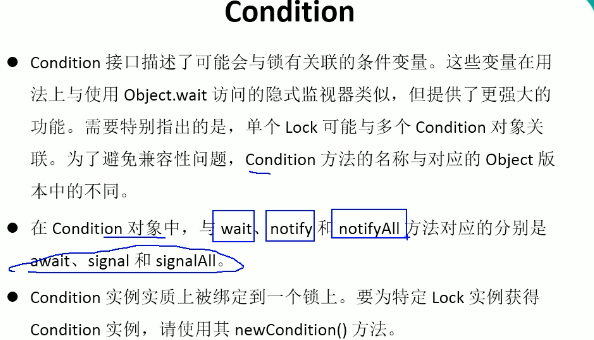

package com.atguigu.juc; import java.util.concurrent.locks.Condition; import java.util.concurrent.locks.Lock; import java.util.concurrent.locks.ReentrantLock; /* * 生产者消费者案例: */ public class TestProductorAndConsumerForLock { public static void main(String[] args) { Clerk clerk = new Clerk(); Productor pro = new Productor(clerk); Consumer con = new Consumer(clerk); new Thread(pro, "生产者 A").start(); new Thread(con, "消费者 B").start(); // new Thread(pro, "生产者 C").start(); // new Thread(con, "消费者 D").start(); } } class Clerk { private int product = 0; private Lock lock = new ReentrantLock(); private Condition condition = lock.newCondition(); // 进货 public void get() { lock.lock(); try { if (product >= 1) { // 为了避免虚假唤醒,应该总是使用在循环中。 System.out.println("产品已满!"); try { condition.await(); } catch (InterruptedException e) { } } System.out.println(Thread.currentThread().getName() + " : " + ++product); condition.signalAll(); } finally { lock.unlock(); } } // 卖货 public void sale() { lock.lock(); try { if (product <= 0) { System.out.println("缺货!"); try { condition.await(); } catch (InterruptedException e) { } } System.out.println(Thread.currentThread().getName() + " : " + --product); condition.signalAll(); } finally { lock.unlock(); } } } // 生产者 class Productor implements Runnable { private Clerk clerk; public Productor(Clerk clerk) { this.clerk = clerk; } @Override public void run() { for (int i = 0; i < 20; i++) { try { Thread.sleep(200); } catch (InterruptedException e) { e.printStackTrace(); } clerk.get(); } } } // 消费者 class Consumer implements Runnable { private Clerk clerk; public Consumer(Clerk clerk) { this.clerk = clerk; } @Override public void run() { for (int i = 0; i < 20; i++) { clerk.sale(); } } }
7.线程按顺序交替

package com.atguigu.juc; import java.util.concurrent.locks.Condition; import java.util.concurrent.locks.Lock; import java.util.concurrent.locks.ReentrantLock; /* * 编写一个程序,开启 3 个线程,这三个线程的 ID 分别为 A、B、C,每个线程将自己的 ID 在屏幕上打印 10 遍,要求输出的结果必须按顺序显示。 * 如:ABCABCABC…… 依次递归 */ public class TestABCAlternate { public static void main(String[] args) { AlternateDemo ad = new AlternateDemo(); new Thread(new Runnable() { @Override public void run() { for (int i = 1; i <= 20; i++) { ad.loopA(i); } } }, "A").start(); new Thread(new Runnable() { @Override public void run() { for (int i = 1; i <= 20; i++) { ad.loopB(i); } } }, "B").start(); new Thread(new Runnable() { @Override public void run() { for (int i = 1; i <= 20; i++) { ad.loopC(i); System.out.println("-----------------------------------"); } } }, "C").start(); } } class AlternateDemo{ private int number = 1; //当前正在执行线程的标记 private Lock lock = new ReentrantLock(); private Condition condition1 = lock.newCondition(); private Condition condition2 = lock.newCondition(); private Condition condition3 = lock.newCondition(); /** * @param totalLoop : 循环第几轮 */ public void loopA(int totalLoop){ lock.lock(); try { //1. 判断 if(number != 1){ condition1.await(); } //2. 打印 for (int i = 1; i <= 1; i++) { System.out.println(Thread.currentThread().getName() + "\t" + i + "\t" + totalLoop); } //3. 唤醒 number = 2; condition2.signal(); } catch (Exception e) { e.printStackTrace(); } finally { lock.unlock(); } } public void loopB(int totalLoop){ lock.lock(); try { //1. 判断 if(number != 2){ condition2.await(); } //2. 打印 for (int i = 1; i <= 1; i++) { System.out.println(Thread.currentThread().getName() + "\t" + i + "\t" + totalLoop); } //3. 唤醒 number = 3; condition3.signal(); } catch (Exception e) { e.printStackTrace(); } finally { lock.unlock(); } } public void loopC(int totalLoop){ lock.lock(); try { //1. 判断 if(number != 3){ condition3.await(); } //2. 打印 for (int i = 1; i <= 1; i++) { System.out.println(Thread.currentThread().getName() + "\t" + i + "\t" + totalLoop); } //3. 唤醒 number = 1; condition1.signal(); } catch (Exception e) { e.printStackTrace(); } finally { lock.unlock(); } } }
8.ThreadReadWriteLock读写锁
属于乐观锁,因为使用Lock那么不管是读还是写都上锁,这样会影响效率.使用读写锁那么读读(没有写)的时候不需要上锁,写的时候要上锁,这样效率会高些.即只有读的时候可以多线程,写的时候需要单线程.



package com.atguigu.juc; import java.util.concurrent.locks.ReadWriteLock; import java.util.concurrent.locks.ReentrantReadWriteLock; /* * 1. ReadWriteLock : 读写锁 * * 写写/读写 需要“互斥” * 读读 不需要互斥 * */ public class TestReadWriteLock { public static void main(String[] args) { ReadWriteLockDemo rw = new ReadWriteLockDemo(); new Thread(new Runnable() { @Override public void run() { rw.set((int)(Math.random() * 101)); } }, "Write:").start(); for (int i = 0; i < 100; i++) { new Thread(new Runnable() { @Override public void run() { rw.get(); } }).start(); } } } class ReadWriteLockDemo{ private int number = 0; private ReadWriteLock lock = new ReentrantReadWriteLock(); //读 public void get(){ lock.readLock().lock(); //上锁 try{ System.out.println(Thread.currentThread().getName() + " : " + number); }finally{ lock.readLock().unlock(); //释放锁 } } //写 public void set(int number){ lock.writeLock().lock(); try{ System.out.println(Thread.currentThread().getName()); this.number = number; }finally{ lock.writeLock().unlock(); } } }
9.线程八锁

package com.atguigu.juc; /* * 题目:判断打印的 "one" or "two" ? * * 1. 两个普通同步方法,两个线程,标准打印, 打印? //one two * 2. 新增 Thread.sleep() 给 getOne() ,打印? //one two * 3. 新增普通方法 getThree() , 打印? //three one two * 4. 两个普通同步方法,两个 Number 对象,打印? //two one * 5. 修改 getOne() 为静态同步方法,打印? //two one * 6. 修改两个方法均为静态同步方法,一个 Number 对象? //one two * 7. 一个静态同步方法,一个非静态同步方法,两个 Number 对象? //two one * 8. 两个静态同步方法,两个 Number 对象? //one two * * 线程八锁的关键: * ①非静态方法的锁默认为 this, 静态方法的锁为 对应的 Class 实例 * ②某一个时刻内,只能有一个线程持有锁,无论几个方法。 */ public class TestThread8Monitor { public static void main(String[] args) { Number number = new Number(); Number number2 = new Number(); new Thread(new Runnable() { @Override public void run() { number.getOne(); } }).start(); new Thread(new Runnable() { @Override public void run() { // number.getTwo(); number2.getTwo(); } }).start(); /*new Thread(new Runnable() { @Override public void run() { number.getThree(); } }).start();*/ } } class Number{ public static synchronized void getOne(){//Number.class try { Thread.sleep(3000); } catch (InterruptedException e) { } System.out.println("one"); } public synchronized void getTwo(){//this System.out.println("two"); } public void getThree(){ System.out.println("three"); } }
10.线程池
1.线程池与callable使用:获取每个线程的执行结果

package com.atguigu.juc; import java.util.ArrayList; import java.util.List; import java.util.concurrent.Callable; import java.util.concurrent.ExecutorService; import java.util.concurrent.Executors; import java.util.concurrent.Future; /* * 一、线程池:提供了一个线程队列,队列中保存着所有等待状态的线程。避免了创建与销毁额外开销,提高了响应的速度。 * * 二、线程池的体系结构: * java.util.concurrent.Executor : 负责线程的使用与调度的根接口 * |--**ExecutorService 子接口: 线程池的主要接口 * |--ThreadPoolExecutor 线程池的实现类 * |--ScheduledExecutorService 子接口:负责线程的调度 * |--ScheduledThreadPoolExecutor :继承 ThreadPoolExecutor, 实现 ScheduledExecutorService * * 三、工具类 : Executors * ExecutorService newFixedThreadPool() : 创建固定大小的线程池 * ExecutorService newCachedThreadPool() : 缓存线程池,线程池的数量不固定,可以根据需求自动的更改数量。 * ExecutorService newSingleThreadExecutor() : 创建单个线程池。线程池中只有一个线程 * * ScheduledExecutorService newScheduledThreadPool() : 创建固定大小的线程,可以延迟或定时的执行任务。 */ public class TestThreadPool { public static void main(String[] args) throws Exception { //1. 创建线程池 ExecutorService pool = Executors.newFixedThreadPool(5); List<Future<Integer>> list = new ArrayList<>(); for (int i = 0; i < 10; i++) { Future<Integer> future = pool.submit(new Callable<Integer>(){ @Override public Integer call() throws Exception { int sum = 0; for (int i = 0; i <= 100; i++) { sum += i; } return sum; } }); list.add(future); } pool.shutdown(); for (Future<Integer> future : list) { System.out.println(future.get()); } /*ThreadPoolDemo tpd = new ThreadPoolDemo(); //2. 为线程池中的线程分配任务 for (int i = 0; i < 10; i++) { pool.submit(tpd); } //3. 关闭线程池 pool.shutdown();*/ } // new Thread(tpd).start(); // new Thread(tpd).start(); } class ThreadPoolDemo implements Runnable{ private int i = 0; @Override public void run() { while(i <= 100){ System.out.println(Thread.currentThread().getName() + " : " + i++); } } }
2.线程池调度

package com.atguigu.juc; import java.util.Random; import java.util.concurrent.Callable; import java.util.concurrent.Executors; import java.util.concurrent.Future; import java.util.concurrent.ScheduledExecutorService; import java.util.concurrent.TimeUnit; /* * 一、线程池:提供了一个线程队列,队列中保存着所有等待状态的线程。避免了创建与销毁额外开销,提高了响应的速度。 * * 二、线程池的体系结构: * java.util.concurrent.Executor : 负责线程的使用与调度的根接口 * |--**ExecutorService 子接口: 线程池的主要接口 * |--ThreadPoolExecutor 线程池的实现类 * |--ScheduledExecutorService 子接口:负责线程的调度 * |--ScheduledThreadPoolExecutor :继承 ThreadPoolExecutor, 实现 ScheduledExecutorService * * 三、工具类 : Executors * ExecutorService newFixedThreadPool() : 创建固定大小的线程池 * ExecutorService newCachedThreadPool() : 缓存线程池,线程池的数量不固定,可以根据需求自动的更改数量。 * ExecutorService newSingleThreadExecutor() : 创建单个线程池。线程池中只有一个线程 * * ScheduledExecutorService newScheduledThreadPool() : 创建固定大小的线程,可以延迟或定时的执行任务。 */ public class TestScheduledThreadPool { public static void main(String[] args) throws Exception { ScheduledExecutorService pool = Executors.newScheduledThreadPool(5); for (int i = 0; i < 5; i++) { Future<Integer> result = pool.schedule(new Callable<Integer>(){ @Override public Integer call() throws Exception { int num = new Random().nextInt(100);//生成随机数 System.out.println(Thread.currentThread().getName() + " : " + num); return num; } }, 1, TimeUnit.SECONDS); System.out.println(result.get()); } pool.shutdown(); } }
11.ForkJoinPool分支合并框架
多线程问题: 当启动多线程时,比如四个线程,那么有两个顺利执行完成,另外两个还在阻塞,那么就会出现两个繁忙,两个很闲的情况.
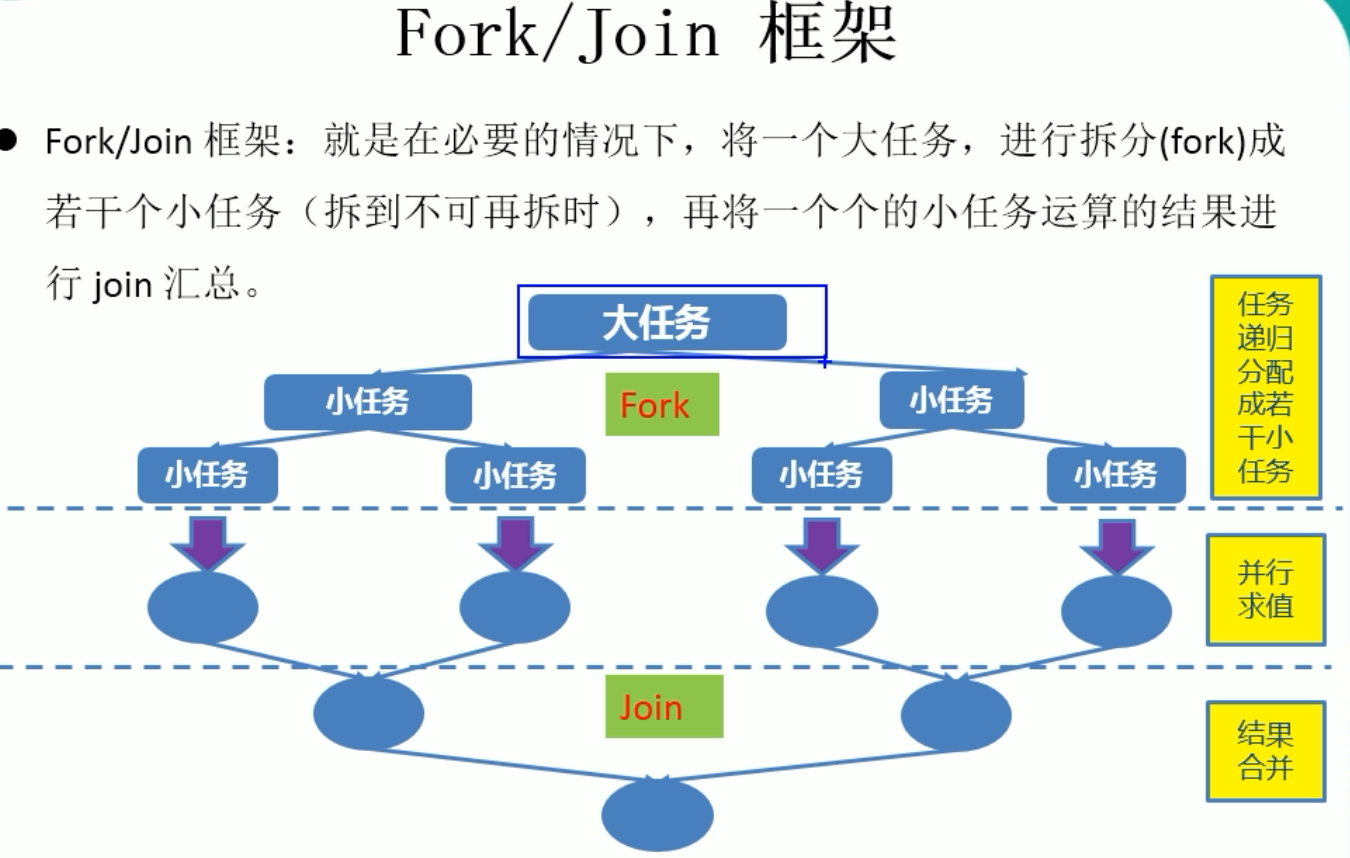

posted on 2019-03-03 09:54 zhulibin2012 阅读(150) 评论(0) 编辑 收藏 举报




